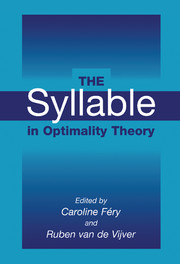Book contents
- Frontmatter
- Contents
- List of Contributors
- Preface
- The Syllable in Optimality Theory
- Part One INTRODUCTION
- Part Two SYLLABLE STRUCTURE AND PROSODIC STRUCTURE
- Part Three NONMORAIC SYLLABLES AND SYLLABLE EDGES
- Part Four SEGMENTS AND SYLLABLES
- 11 On the Sources of Opacity in OT: Coda Processes in German
- 12 Ambisyllabicity and Fricative Voicing in West Germanic Dialects
- 13 The CiV-Generalization in Dutch: What Petunia, Mafia, and Sovjet Tell Us about Dutch Syllable Structure
- 14 The Relative Harmony of /s+Stop/ Onsets: Obstruent Clusters and the Sonority Sequencing Principle
- Part Five HOW CONCRETE IS PHONOTACTICS?
- Author Index
- Languages Index
- Subject Index
12 - Ambisyllabicity and Fricative Voicing in West Germanic Dialects
Published online by Cambridge University Press: 03 July 2009
- Frontmatter
- Contents
- List of Contributors
- Preface
- The Syllable in Optimality Theory
- Part One INTRODUCTION
- Part Two SYLLABLE STRUCTURE AND PROSODIC STRUCTURE
- Part Three NONMORAIC SYLLABLES AND SYLLABLE EDGES
- Part Four SEGMENTS AND SYLLABLES
- 11 On the Sources of Opacity in OT: Coda Processes in German
- 12 Ambisyllabicity and Fricative Voicing in West Germanic Dialects
- 13 The CiV-Generalization in Dutch: What Petunia, Mafia, and Sovjet Tell Us about Dutch Syllable Structure
- 14 The Relative Harmony of /s+Stop/ Onsets: Obstruent Clusters and the Sonority Sequencing Principle
- Part Five HOW CONCRETE IS PHONOTACTICS?
- Author Index
- Languages Index
- Subject Index
Summary
Introduction
In most dialects of the West Germanic dialect continuum – the language area of genetically related dialects stretching out from Frisian at the Dutch and German borders of the North Sea to the Swiss German dialects in the Alps – the relation between voicing and frication is a problematic one: phonological contrasts between voiced and voiceless fricatives tend to get neutralized in many but usually not all positions. Interestingly, these neutralizations do not always occur in the same environment in different dialects, and, furthermore, sometimes one dialect seems to favor, for example, a voiced [z] in an environment in which other dialects show voiceless [s] only.
In this chapter, I study the complex relation between voicing and frication in a number of representative dialects in the West Germanic dialect continuum, namely Frisian, Thurgovian German, Roermond Dutch, and Standard Dutch. My main hypothesis is that voicing does not play a distinctive role in the first three of these systems and only a limited role in the last one. Contrasts between voiced and voiceless fricatives can in almost all cases be reduced to a difference in syllabic affiliation.
This hypothesis has a number of implications within the particular framework of phonology in which I present my ideas, Optimality Theory (OT – Prince and Smolensky 1993 and subsequent work):
First, saying that some phonological property is “distinctive” implies that it is at least potentially underlying within this framework, like in any other theory of generative phonology.
- Type
- Chapter
- Information
- The Syllable in Optimality Theory , pp. 304 - 337Publisher: Cambridge University PressPrint publication year: 2003
- 5
- Cited by



